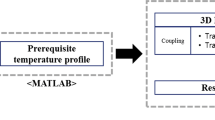Abstract
The present paper introduces a numerical study on the fire behavior of composites during exposure to a heating source at high incident power. A novel numerical model is proposed which is able to simulate the behavior of composite materials in fire environment providing the composites mass loss rate and heat release rate during heating source application. Two commercial software have been selected as platforms for the implementation of the proposed numerical model COMSOL and ANSYS. In COMSOL the model has been implemented by introducing proper field equations, while a macro, written in Ansys Parametric Design Language, has been used to allow the ANSYS FEM code to numerically simulate, by an incremental procedure, all the relevant physical phenomena related to fire. As an application, an experiment on thermal degradation over a laminated composite plate has been numerically simulated and the numerical model has been validated by comparing the COMSOL and Ansys numerical results to experimental literature data in terms of temperature profile over the panel thickness, Mass Loss Rate and Heat Release Rate. An excellent agreement has been found between the obtained numerical results and the experimental test data for both the adopted numerical platforms. However the ANSYS implementation, which showed to be the most effective in terms of accuracy of results and perspectives of applications to complex numerical models, led to the definition of a powerful tool able to assesses the fire performance of composite structures.












Similar content being viewed by others
References
Bamford, C.H., Crank, D.H., Mala, J.: The combustion of wood. Part1. Camb. Philos. Soc. Proc. Biol Sci. 42, 166–182 (1946)
Kung, H.C.: A mathematical model of wood pyrolysis. Combust. Flame 18(2), 185–195 (1972)
Munson, T.R., Mascola, R.E., Brown, J.D.: An advanced analytical program for charring ablators - Final report - Volume 1 - Analytical formulation, data interpretation and flight simulation NASA document number: AVSSD-0172-67-RR (1967)
Henderson, J.B., Wiebelt, J.A., Tant, M.R.: A model for the thermal response of polymer composite materials with experimental verification. J. Compos. Mater. 19, 579–595 (1985)
Dimitrienko, Y.I.: Themomechanical behaviour of composite materials under high temperatures: 1 Materials. Compos. Part A 28A, 453–461 (1997)
Lua, J., O’Brien, J., Key, C.T., Wu, Y., Lattimer, B.Y.: A temperature and mass dependent thermal model for fire response prediction of marine composites. Composite Part A 37, 1024–1039 (2006)
Di Blasi, C., Galgano, A., Branca, C.: Modeling the thermal degradation of poly(methyl methacrylate)/carbon nanotube nanocomposites. Polym. Degrad. Stab. 98, 266–275 (2013)
Galgano, A., Di Blasi, C., Branca, C., Milella, E.: Thermal response to fire of a fibre-reinforced sandwich panel: Model formulation, selection of intrinsic properties and experimental validation. Polym. Degrad. Stab. 94(8), 1267–1280 (2009)
Dodds, N., Gibson, A.G., Dewhurst, D., Davies, J.M.: Fire behavior of a composite material. Compos. Part A 31, 689–702 (2000)
Sikoutris, D.E., Vlachos, D.E., Kostopoulos, V., Jagger, V., Jagger, S., Ledin, S.: Fire Burnthrough Response of CFRP Aerostructures. Numerical Investigation and Experimental Verification. Appl. Compos. Mater 19(2), 141–159 (2012)
La Delfa, G., Urso-Miano, V., Gibson, A.: Characterisation and modelling of structural integrity of carbon fibre wing box laminate subject to fire. Plast. Rubber. Compos. 38(9–10), 367–373 (2009)
Miano, V., Gibson, A.: FIRE model for fibre reinforced plastic composites using Apparent thermal diffusivity (ATD). Plast. Rubber. Compos. 38(2–4), 87–92 (2009)
Mouritz, A.P., Gibson, A.G.: Fire properties of polymer composite materials. Springer, Dordrecht (2006)
Lattimer, B.Y., Ouellette, J., Trelles, J.: Thermal response of composite materials to elevated temperatures. Fire. Technol 47, 823–850 (2011)
Lattimer, B.Y., Hunt, S.P., Wright, M., Sorathia, U.: Modeling fire growth in a combustible corner. Fire Saf. J. 38, 771–796 (2003)
Mouritz, A.P., Feih, S., Kandare, E., Mathys, Z., Gibson, A.G., Des Jardin, P.E., Case, S.W., Lattimer, B.Y.: Review of fire structural modelling of polymer composites. Compos. Part A 40, 1800–1814 (2009)
The finite element method. In: COMSOL multiphysics reference guide, pp. 570–571. COMSOL, Los Angeles (2012)
Element Library. In: Theory reference for mechanical APDL and mechanical applications, pp. 775–781. Ansys Inc., Canonsburg (2009)
Author information
Authors and Affiliations
Corresponding author
Rights and permissions
About this article
Cite this article
Riccio, A., Damiano, M., Zarrelli, M. et al. Simulating the Response of Composite Plates to Fire. Appl Compos Mater 21, 511–524 (2014). https://doi.org/10.1007/s10443-013-9357-0
Received:
Accepted:
Published:
Issue Date:
DOI: https://doi.org/10.1007/s10443-013-9357-0




